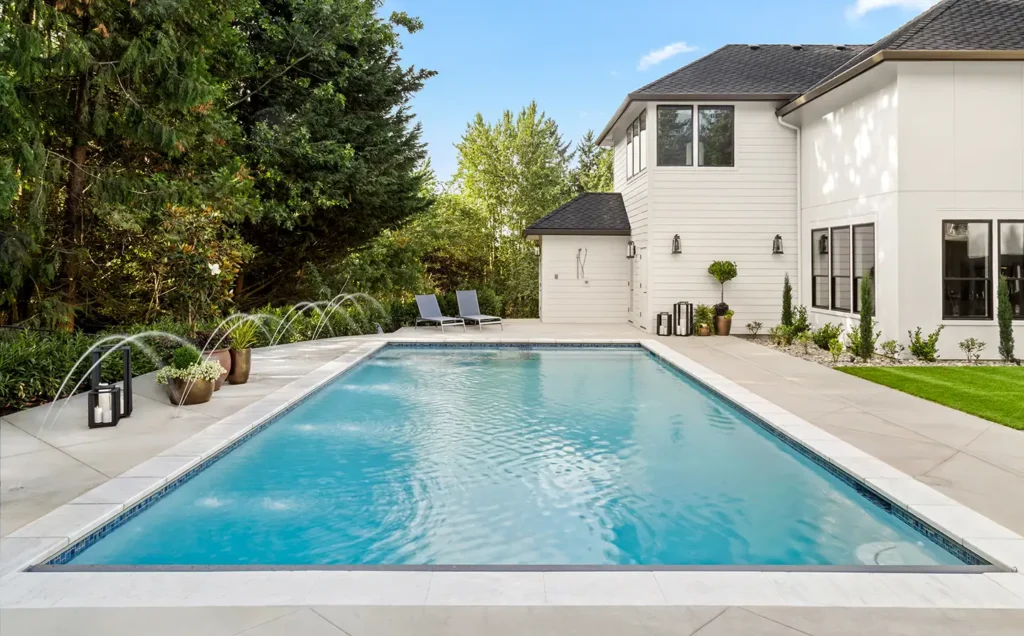Swimming pools and spas are a great way to relax and have fun, especially during the hot Houston summer months.
But like everything else, they need some care and maintenance.
One of the most common maintenance tasks is pool resurfacing.
In this article, we’ll dive deep into the world of pool resurfacing, explaining the process, costs, variables, and common problems to avoid.
1. What is Pool Resurfacing?
Pool resurfacing is an intricate and essential process that rejuvenates the appearance and functionality of your swimming pool.
It’s akin to giving your pool a comprehensive makeover, ensuring it remains both aesthetically pleasing and safe for use.
Let’s delve deeper into the nuances of pool resurfacing:
1.1. The Need for Resurfacing Pool Services
Over the years, a swimming pool’s surface undergoes wear and tear due to various factors:
- Chemical Erosion: The chemicals used to keep the pool clean, like chlorine, can erode the pool’s surface over time.
- Physical Damage: External factors like falling debris, rough usage, or even the natural settling of the ground can lead to cracks and chips in the pool’s surface.
- Algae and Stains: Algae can form on surfaces that aren’t regularly cleaned, and metal objects left in the pool can cause rust stains.
- Natural Aging: Just like everything else, the materials used in pool surfaces degrade over time, leading to discoloration and a rough texture.
1.2. The Essence of Pool Resurfacing Houston
Resurfacing is not just about making the pool look good; it’s about addressing the above issues and ensuring the pool remains functional.
The process involves:
- Stripping Away the Old: The damaged or aged layer of the pool’s surface is removed, revealing the base layer underneath.
- Repair and Prep: Any cracks, divots, or imperfections in this base layer are then repaired and smoothed out to prepare for the new surface.
- Application of New Surface: A fresh layer of the chosen material, be it plaster, fiberglass, or an aggregate finish, is applied. This new layer is meticulously smoothed out, ensuring an even and durable surface.
- Finishing Touches: Depending on the chosen material, there might be additional steps like acid washing or adding decorative tiles.

1.3. The Benefits of Swimming Pool Repair
- Aesthetic Appeal: A newly resurfaced pool looks clean, shiny, and inviting.
- Safety: A smooth surface ensures swimmers are not at risk of cuts or abrasions.
- Longevity: Resurfacing can extend the life of your pool by several years, ensuring you get the most out of your investment.
- Property Value: A well-maintained pool can increase the value of your property.
In essence, pool resurfacing is a blend of art and science, ensuring that your pool remains a safe and beautiful oasis in your backyard.
2. The Detailed Process of Houston Pool Resurfacing and Pool Repairs
Swimming pool resurfacing is a meticulous procedure that requires precision, expertise, and a thorough understanding of the materials and techniques involved.
Let’s delve into each step of the process in greater detail:
2.1. Inspection
Objective: To assess and review the current state of the pool and identify any underlying issues.
- Visual Examination: Professionals begin with a visual inspection to identify visible damages like cracks, stains, and discolorations.
- Structural Assessment: They will tap the pool’s surface with a tool to detect hollow spots, which can indicate delamination or separation of the surface material from the base.
- Equipment Check: The pool’s filtration system, lights, and other fixtures are also examined to ensure they are functioning correctly.
- Report & Recommendation: Post-inspection, the professionals will provide a detailed report outlining the issues and suggesting the best resurfacing method and materials suitable for your pool.
2.2. Draining
Objective: To empty the filter pool and expose the entire surface for treatment.
- Water Removal: Using powerful submersible pumps, the water is drained out of the pool. This process can take several hours, depending on the pool’s size.
- Safety Measures: Care is taken to ensure that the pool’s structure is not compromised due to the sudden pressure change from draining.
2.3. Cleaning
Objective: To prepare the pool’s surface for the resurfacing process.
- Scrubbing: The dry pool surface is scrubbed to remove any algae, calcium deposits, and other contaminants.
- Pressure Washing: A high-pressure washer is used to deep clean the surface, ensuring that all residues are removed, and the surface is smooth.

2.4. Removing Old Surface
Objective: To strip away the deteriorated surface layer and expose the base.
- Chipping: Using pneumatic tools, the old surface material is chipped away. This process ensures that the new surface adheres properly.
- Debris Removal: All the chipped material and debris are removed and disposed of properly to ensure a clean working environment.
2.5. Applying New Surface
Objective: To lay down a fresh, durable layer on the swimming pool heater.
- Material Mixing: The chosen resurfacing material, whether plaster, fiberglass, or an aggregate finish, is mixed to the right consistency.
- Application: Professionals apply the material evenly over the pool’s surface. They use trowels and other tools to smooth out the material, ensuring a uniform thickness.
- Detailing: Special attention is given to the pool’s edges, steps, and other features to ensure a seamless finish.
2.6. Curing
Objective: To allow the new surface to set and achieve maximum strength.
- Setting Time: The freshly applied surface is left undisturbed to set. This can take anywhere from a few days to a week, depending on the material and weather conditions.
- Moisture Maintenance: The surface may be lightly misted with water periodically to prevent it from drying out too quickly, which can cause cracking.
2.7. Refilling
Objective: To prepare the pool for use once again.
- Water Introduction: Once the surface is fully cured, the pool is slowly refilled with water. This gradual process ensures that the new surface doesn’t get damaged.
- Chemical Balancing: Before the pool is ready for use, the water’s chemical balance is restored to ensure it’s safe for swimming.
Pool resurfacing is a detailed and systematic process that rejuvenates your pool, ensuring it remains a centerpiece of relaxation and enjoyment in your home.
Proper execution of each step is crucial to achieve a long-lasting and beautiful result.
4. Key Variables to Consider in Pool Resurfacing
When planning to resurface your pool, several factors can influence the process, outcome, and cost.
It’s essential for companies to be aware of these variables to ensure a successful resurfacing project.

4.1. Pool Age
- Wear and Tear: Older pools have endured more years of chemical treatments, weather exposure, and general use. This can lead to more extensive wear and tear, requiring more intensive repair work.
- Outdated Materials: Pools built several decades ago might have been constructed with materials that are now considered outdated or less durable. Upgrading to modern materials can enhance the pool’s longevity and appearance.
4.2. Previous Resurfacing
- Layering Issues: If a pool has been resurfaced multiple times, there might be multiple layers of material on the pool’s shell. This can complicate the removal process and might require more time.
- Material Compatibility: The type of material used in previous resurfacing jobs can affect the choice of material for the current project. Some materials might not adhere well to certain pre-existing surfaces.
4.3. Weather Conditions
- Curing Time: Humidity and temperature play a significant role in the curing time of the resurfacing material. For instance, high humidity can prolong the drying time, while extreme temperatures can cause the material to set too quickly or not at all.
- Work Delays: Rain or other adverse weather conditions can delay the resurfacing process, as it’s crucial to work on a dry and clean surface.
5. Common Pitfalls in Pool Resurfacing and How to Avoid Them
Resurfacing a pool is a significant investment, and avoiding common mistakes can save both time and money.
Here are some pitfalls to watch out for:
5.1. DIY Swimming Pool Resurfacing
- Lack of Expertise: Pool resurfacing requires specialized knowledge and tools. Attempting to do it yourself without the necessary expertise can lead to uneven surfaces, bubbles, or even structural issues.
- Recommendation: Always hire professionals with a proven track record in pool resurfacing. Their experience will ensure a smooth and durable finish.

5.2. Inconsistent Pool Service and Maintenance
- Accelerated Wear: Pools that aren’t regularly cleaned and balanced chemically can show signs of wear faster than well-maintained ones.
- Recommendation: Set a regular maintenance schedule. Clean the pool, check chemical levels, and inspect for damages regularly to prolong the life of the surface.
5.3. Opting for Low-Quality Materials or Pool Equipment
- Short Lifespan: Cheaper materials might save money initially but can degrade faster, leading to frequent resurfacing needs.
- Recommendation: Invest in high-quality, durable materials. While the upfront cost might be higher, the long-term savings and enhanced pool appearance are worth it.
5.4. Overlooking Minor Damages
- Compounding Issues: Small cracks or chips can expand over time, leading to significant structural problems and potential leaks.
- Recommendation: Address minor damages immediately. Regular inspections can help identify and fix issues before they escalate.
Understanding the variables that influence pool resurfacing and being aware of common pitfalls can ensure a successful, long-lasting resurfacing project.
Proper care and attention to detail will keep your pool and spa looking and functioning at its best.
Pool Resurfacing: Revitalizing Houston's Swimming PoolsConclusion
Pool resurfacing is an essential part of pool maintenance.
It can give your pool a fresh look and extend its life.
By understanding the process, costs, and potential problems, you can make informed decisions and enjoy your pool for many years to come.
Remember, a well-maintained pool is not just beautiful but also safe for everyone.
FAQ: Pool Resurfacing Guide
1. What is pool resurfacing?
Pool resurfacing is the process and job of rejuvenating the appearance and functionality of a swimming pool by replacing its old or damaged surface with a new one.
2. Why is pool resurfacing important?
Over time, the surface of a pool can become damaged, stained, or simply show signs of aging.
Resurfacing and pool repairs helps in restoring the pool’s aesthetic appeal, ensuring safety, and extending its lifespan.
3. What are the steps involved in pool resurfacing?
The main steps include:
- Inspection of the pool.
- Draining the pool.
- Cleaning the old surface.
- Removing the old surface.
- Applying a new surface.
- Allowing the new surface to cure.
- Refilling the pool.
4. How does the age of the pool affect resurfacing?
Older pools might have more wear and tear and may have been constructed with outdated materials. This can lead to the need for more intensive repair and updating during resurfacing services.
5. How does previous resurfacing impact the current process?
If a pool has been resurfaced before, there might be multiple layers of material on the pool’s shell, which can complicate the removal process.
The type of material used previously can also affect the choice of material for the current project.
6. How do weather conditions influence pool resurfacing?
Weather conditions, especially humidity and temperature, can affect the curing time of the resurfacing material.
Adverse weather like rain can also delay the process.
7. What are some common mistakes to avoid during pool resurfacing?
Some common pitfalls include:
- Attempting DIY resurfacing without professional expertise.
- Not maintaining the pool regularly.
- Using cheap or low-quality materials.
- Ignoring minor damages to the pool surface.
8. Why is it recommended to hire professionals for pool resurfacing?
Professionals have the necessary expertise, tools, and experience to ensure a smooth and durable finish.
They can also address any underlying issues and provide recommendations for any repairs using the best materials and methods.
9. How can one maintain the pool post-resurfacing?
Regular cleaning, checking chemical levels, and inspecting for damages can prolong the life of the newly resurfaced pool.
It’s also essential to address any minor damages immediately to prevent them from escalating.
RJT Construction can assist you with pool remodeling, pool renovation, repair services, new water features, leak detection services, new pool pump install, pool lighting, led lighting, cartridge filters, replace heaters, new variable speed pumps, repair services for an existing pool, motor repair, fixed pool, pool upgrade, advanced pool systems, and more.
We focus on efficient and reliable pool solutions.
Pool Owner? Give us a service call today! Our team is standing by.
We’re a family owned and operated local construction company and provide an excellent warranty.
We also service:
The Greater Houston Area.
Katy, TX
Missouri City, TX
League City, TX
Bellaire, TX
Sugar Land, TX
Dickinson, TX
The Woodlands, TX
Humble, TX
Conroe, TX
Beaumont, TX
And more.





